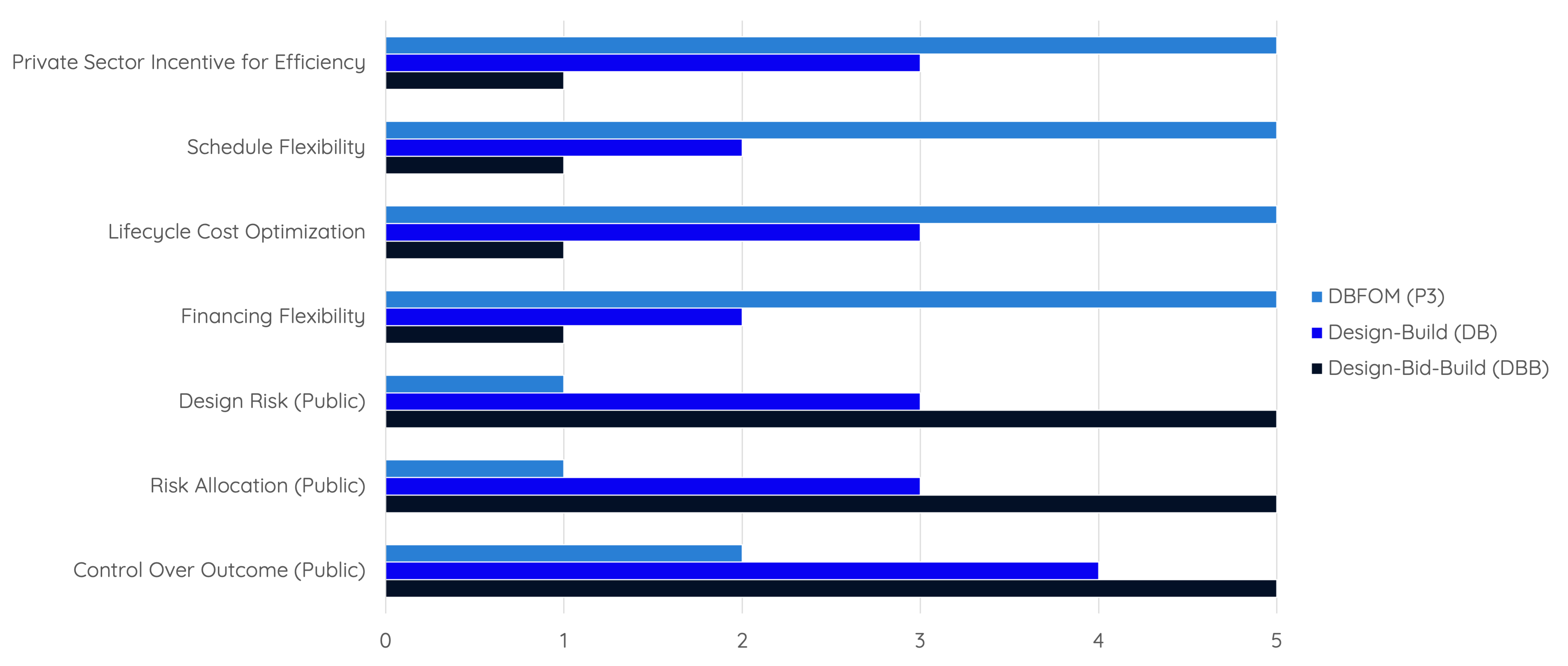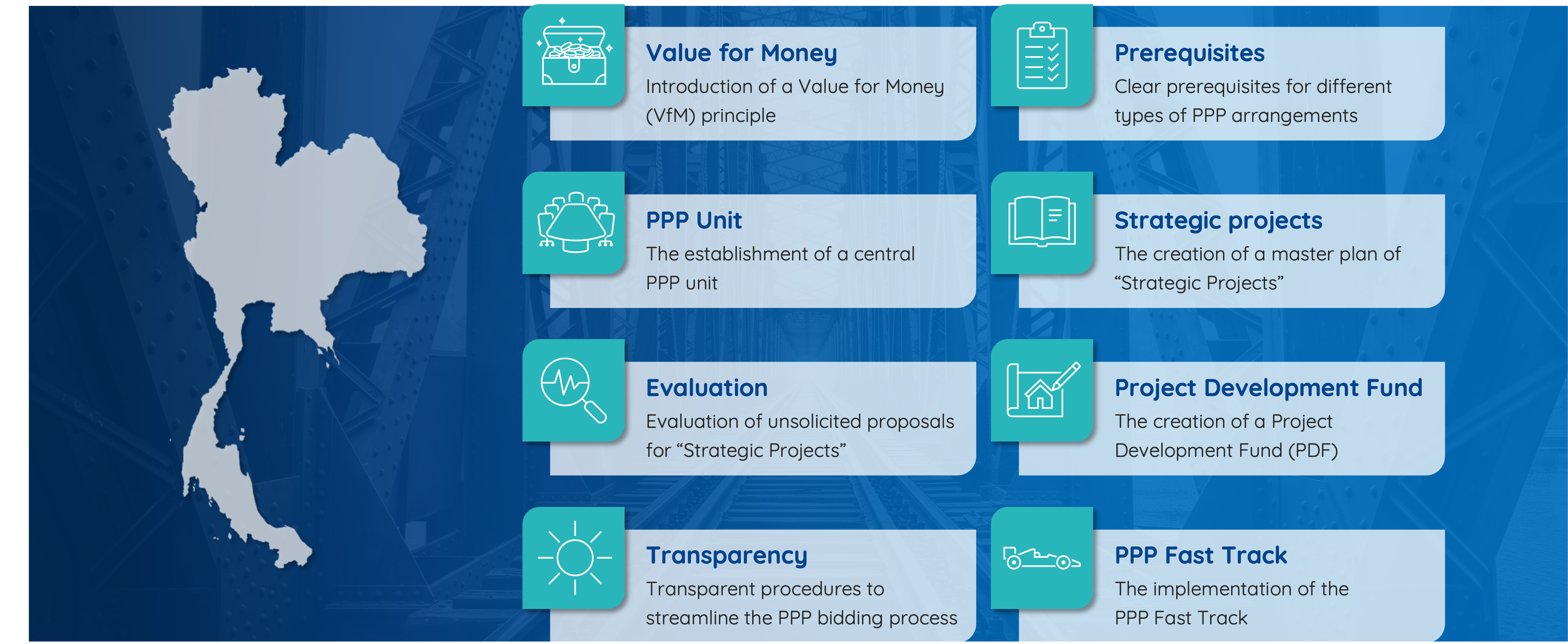Introduction
Public-Private Partnerships (PPPs) are increasingly being adopted across the globe as a solution to meet the growing demand for infrastructure development, especially in emerging markets. These partnerships allow the public sector to leverage private sector efficiency, innovation, and financing capabilities. While PPPs come in many forms, this analysis focuses on those structured with availability payments, an approach that provides distinct advantages, particularly when revenue generation from the infrastructure is not feasible or unpredictable.
At MPG, we leverage our extensive expertise in public-private partnerships and project finance, with a focus on PPP law in Thailand, to provide insights grounded in global best practices, including availability payment structures, and offer an assessment of how these models can be effectively applied in the Thai context.
1. Understanding Availability Payments in PPPs
Availability payments in PPPs provide compensation to private partners based on performance rather than direct user-generated revenues. This model is particularly useful when infrastructure projects do not generate adequate revenue through tolls or user fees to cover operational costs and debt service, but where public availability of the asset is critical.
In availability payment models:
✓ The private partner designs, builds, finances, operates, and maintains the infrastructure.
✓ Payments are made by the public sector based on the asset being “available” and meeting certain performance standards.
✓ The government retains control over pricing (e.g., tolls) or user fees, if applicable, while the private partner is incentivized to meet contractual service and quality benchmarks.
This model is contrasted with user fee-based PPPs, where the private partner collects revenues directly from users (e.g., toll roads), assuming demand and revenue risk.

2. Advantages of Availability Payment Structures
There are several key benefits to structuring PPPs with availability payments:
1. Risk Transfer: Availability payments transfer design, construction, and operational risks to the private sector while allowing the public sector to retain control over demand risks. This can be particularly beneficial in projects where revenue generation is uncertain.
2. Incentivized Performance: Payments are directly tied to the operational performance of the asset, which ensures the private partner is highly motivated to maintain quality and safety standards.
3. Budget Certainty: Since availability payments are pre-defined, they provide predictable, long-term budgetary obligations for the public sector.
4. Faster Delivery: With payments beginning only after project completion, private partners are incentivized to complete the project efficiently and on time.
3. Challenges and Considerations
While availability payments offer distinct benefits, they also present challenges:
✓ Higher Private Financing Costs: As noted in the attached paper, private financing often carries a higher cost than public borrowing. The success of PPPs depends on whether efficiency gains in construction, operation, and maintenance outweigh these additional financing costs.
✓ Risk of Underperformance: If the private partner fails to meet availability or performance standards, the public sector may reduce payments or terminate the contract. This risk is mitigated by thorough due diligence during the procurement process.
4. PPP in Thailand: Legal Framework and Challenges
Thailand has been increasingly receptive to PPPs as a mechanism to meet its infrastructure needs. The Public-Private Partnership Act B.E. 2562 (2019) provides the legal foundation for PPPs in Thailand, outlining the processes and frameworks under which these partnerships are to be structured. This law aims to streamline the approval process for PPP projects and improve transparency in procurement.
However, several challenges still need to be addressed to ensure the success of availability payment PPPs in Thailand:
✓ Regulatory Certainty: While the PPP Act provides a strong framework, regulatory certainty is critical, particularly concerning long-term contracts. Investors need to have confidence in Thailand’s legal and regulatory environment to commit to large-scale infrastructure projects.
✓ Political Stability: The success of PPPs, especially those requiring long-term commitments from the public sector, hinges on political stability. Changes in government policies or leadership can introduce risks for private investors.
✓ Capacity of Public Institutions: Effective management of PPP contracts, especially those involving availability payments, requires a high level of expertise in both public institutions and regulatory agencies. Thailand must continue to build capacity within these organizations to ensure the successful implementation and oversight of PPP projects.

Figure 2. Key points of the Thai Public-Private Partnership Act, B.E. 2562 (2019).
5. Applying Availability Payments in Thailand
Availability payment structures could be particularly useful for a number of infrastructure projects in Thailand, including:
✓ Mass Transit Systems: Public transportation infrastructure often does not generate enough revenue to cover costs but is essential for economic growth. Bangkok’s expanding mass transit system, for instance, could benefit from availability payment PPPs, where private partners handle construction and operations, while the government retains control over fare-setting and availability.
✓ Healthcare Infrastructure: Availability payments could also be applied to the construction and management of public hospitals or healthcare facilities. Private partners could be compensated based on the availability and performance of the facilities, ensuring that public health outcomes are met without the need for user fees.
✓ Educational Infrastructure: In the UK and Canada, over 500 projects, including schools and hospitals, have successfully used availability payment frameworks. Thailand could adopt a similar model for the development of schools, particularly in rural areas, where user fees are not feasible.
6. Best Practices for Structuring Availability Payment PPPs
To maximize the success of availability payment PPPs in Thailand, several best practices can be adopted:
1. Clear Performance Metrics: The success of availability payment structures depends on the ability to define clear, measurable performance metrics. These metrics should be carefully designed to ensure that private partners are incentivized to maintain the asset at a high standard over the contract term.
2. Robust Value-for-Money (VfM) Analysis: As highlighted in the paper, a thorough VfM analysis should be conducted before deciding on the procurement strategy. This analysis compares the cost-effectiveness of public procurement versus a PPP approach, considering factors such as financing costs, construction and operation efficiencies, and risk transfer.
3. Transparent and Competitive Procurement Process: A transparent procurement process that attracts competitive bids is essential for ensuring that the public sector captures the efficiency gains promised by PPPs. Thailand should continue to refine its procurement processes to increase transparency and predictability for investors.
4. Risk Allocation: One of the key tenets of PPPs is that risks should be allocated to the party best able to manage them. In availability payment structures, construction and operational risks should be borne by the private sector, while the public sector retains control over demand and policy risks.
7. Conclusion: The Path Forward for Thailand
As Thailand continues to expand its infrastructure to meet the demands of its growing economy, public-private partnerships will play an increasingly important role. The availability payment model offers a flexible, performance-based approach to financing and delivering essential infrastructure projects where direct revenue generation may be limited or uncertain.
By applying global best practices, conducting thorough Value-for-Money analyses, and ensuring a stable regulatory environment, Thailand can position itself to attract private investment and successfully deliver infrastructure projects that meet the needs of its citizens.
Moving forward, the Thai government should continue to refine its PPP policies, build institutional capacity, and ensure that the regulatory framework supports long-term infrastructure development. Availability payment PPPs, when properly structured and implemented, offer a viable solution to the challenges of infrastructure financing and delivery, ensuring that Thailand can continue to grow and thrive in the years to come.